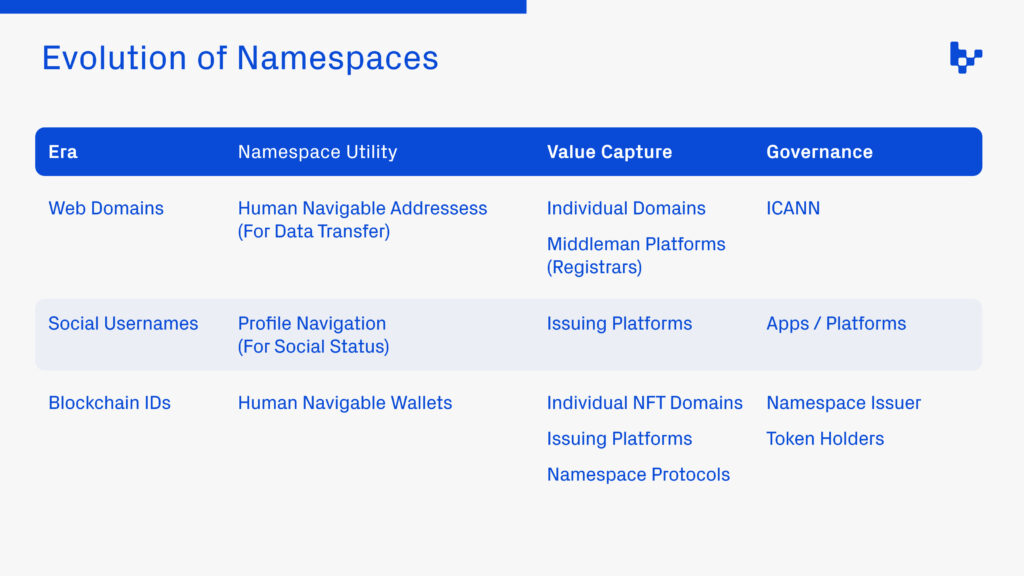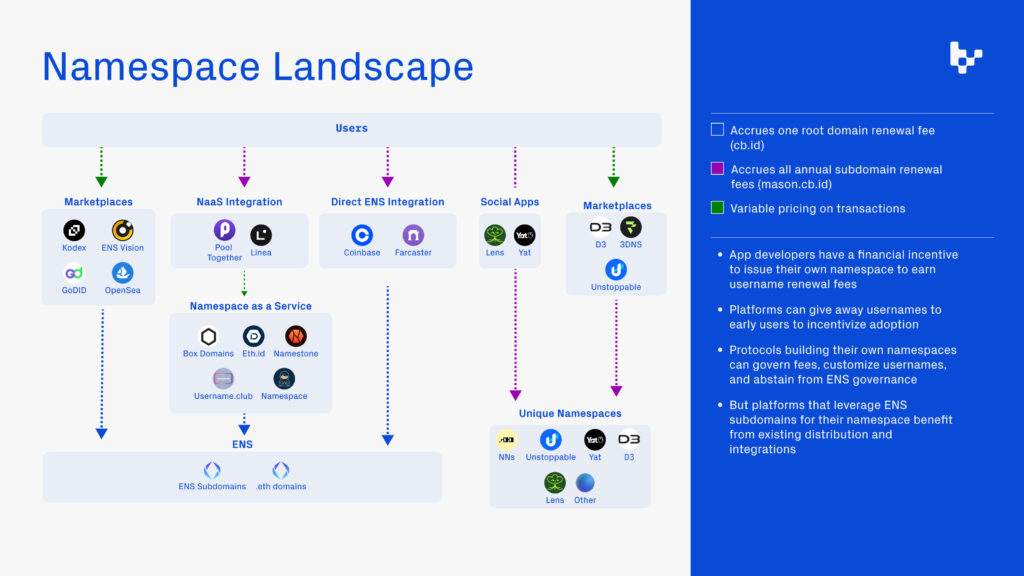Mason Nystrom
Onchain Namespaces: An Emerging Crypto Business Model
ENS built a strong business issuing .eth usernames, and now that model is catching on fast.
A handful of new companies have emerged that provide namespaces as a service to projects and individuals, and I think there are enough of them now to call it an exciting new trend. Namespaces offer a viable business model for a subset of consumer applications that own large distribution channels.
Whether it’s a domain extension, social media username, or phone number (e.g. 1-800-FLOWERS), unique digital identifiers have been coveted since the issuance of the first web domains, which converted IP addresses into human-readable names and gained value via their searchability with the continued adoption of the internet. Surprisingly, the rise of social networks made the market for namespaces less liquid, since you can’t easily buy someone’s handle on web2 social platforms. Twitter even banned the sale of handles, which is ironic for a company in dire need of more sustainable cash flows.
Although the .eth namespace has been around for years, the integration of a cross-chain interoperability protocol (CCIP) has further spurred the creation of new namespaces by connecting ENS subdomains with traditional, offchain domain names. For example, in August Coinbase leveraged ENS and CCIP to start offering its users blockchain usernames under the DNS domain cb.id (masongnystrom.cb.id is both a DNS address and a web3 wallet).
With the rise of namespace issuers, crypto consumer applications will have the opportunity to create their own native namespaces—but this time around, we’ll be able to own social usernames or have governance over the root namespaces (e.g. ENS). With that capability will come lucrative opportunities for the top crypto consumer applications and their early users.
To date, blockchain projects that wanted to create onchain namespaces have opted for one of two paths: 1) launch their namespace using ENS subdomains, or 2) launch their own app-native namespace protocol that serves their platform.
Deciding whether to build your own namespace
Social graphs like ENS can be leveraged to bootstrap an identity layer for a new application. Coinbase, a platform where the user’s public-facing identity isn’t fundamental to the product experience, has opted to use ENS subdomains to generate user identities quickly while also enjoying benefits such as DNS compatibility and integrations with prominent distribution layers such as MetaMask. Farcaster has similarly decided to leverage ENS because it possesses a base of high-value users who want to display their existing identity (e.g. their .eth address) within Farcaster’s social graph.
On the other hand, projects like Lens and Yat have opted to issue usernames separate from the ENS ecosystem by creating their own namespace protocols. These unique namespaces carry similar value propositions to ENS subdomains but have the distinct benefits of greater protocol flexibility, autonomy from a third-party issuer, and the ability to earn fees from namespace issuance and annual renewal fees.
And charging for namespace renewal in social networks serves a purpose beyond generating revenue: it prevents squatting on valuable namespaces by speculators, which is good for a social network as it matures and onboards more users. Moreover, crypto social apps or protocols like Lens will use usernames from their unique namespace as an incentive to join the network, offering firstcomers their preferred namespace plus the potential to monetize the namespaces at a later point in time once some network density has been achieved.
However, platforms that build their own namespace protocols forgo the benefits that come with building on top of ENS, most notably a substantial ecosystem of integrations and an existing user base of people who already possess a .eth address and speculate on ENS-related subdomains.
Onchain namespaces offer a viable business model and incentive mechanism for new types of crypto social networks. Most applications will be best served by leveraging ENS subdomains as their namespace and issuing those usernames to their users for free. Platforms that have socially relevant namespaces or that have sufficient discovery and distribution (e.g. social networks) will have the greatest chance of bootstrapping their own namespace protocols and charging renewal fees for usernames in the long run.
If you’re building new social applications leveraging unique namespaces, I want to hear from you: [email protected].
+++
This post is for general information purposes only. It does not constitute investment advice or a recommendation or solicitation to buy or sell any investment and should not be used in the evaluation of the merits of making any investment decision. It should not be relied upon for accounting, legal or tax advice or investment recommendations. You should consult your own advisers as to legal, business, tax, and other related matters concerning any investment. Certain information contained in here has been obtained from third-party sources, including from portfolio companies of funds managed by Variant. While taken from sources believed to be reliable, Variant has not independently verified such information. Variant makes no representations about the enduring accuracy of the information or its appropriateness for a given situation. This post reflects the current opinions of the authors and is not made on behalf of Variant or its Clients and does not necessarily reflect the opinions of Variant, its General Partners, its affiliates, advisors or individuals associated with Variant. The opinions reflected herein are subject to change without being updated. Variant is an investor in Lens.


